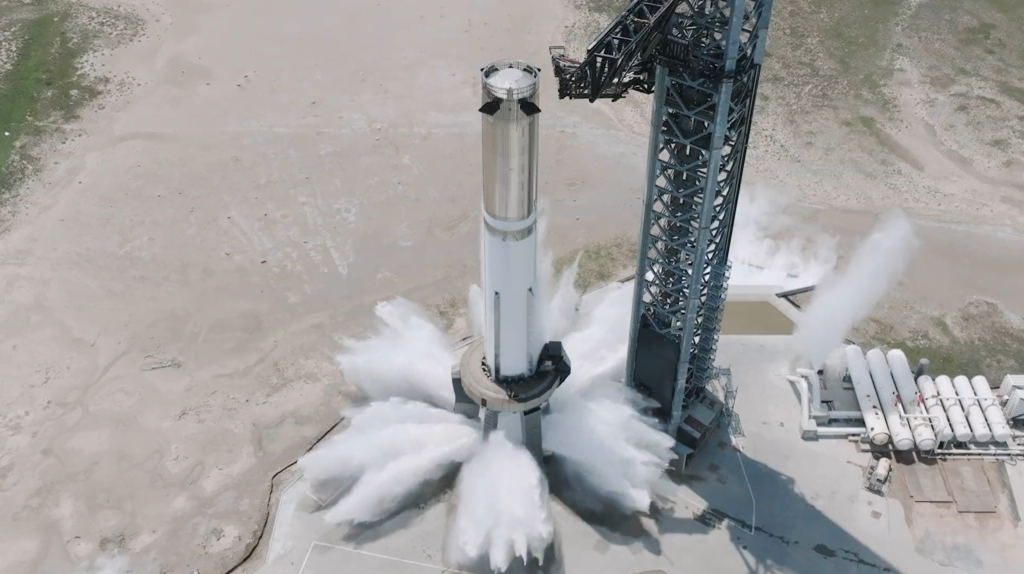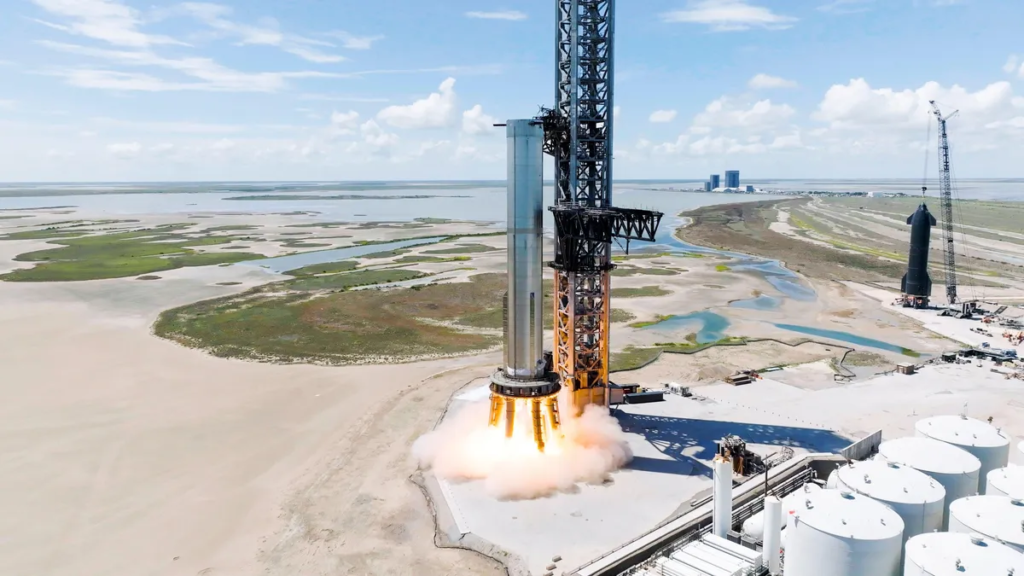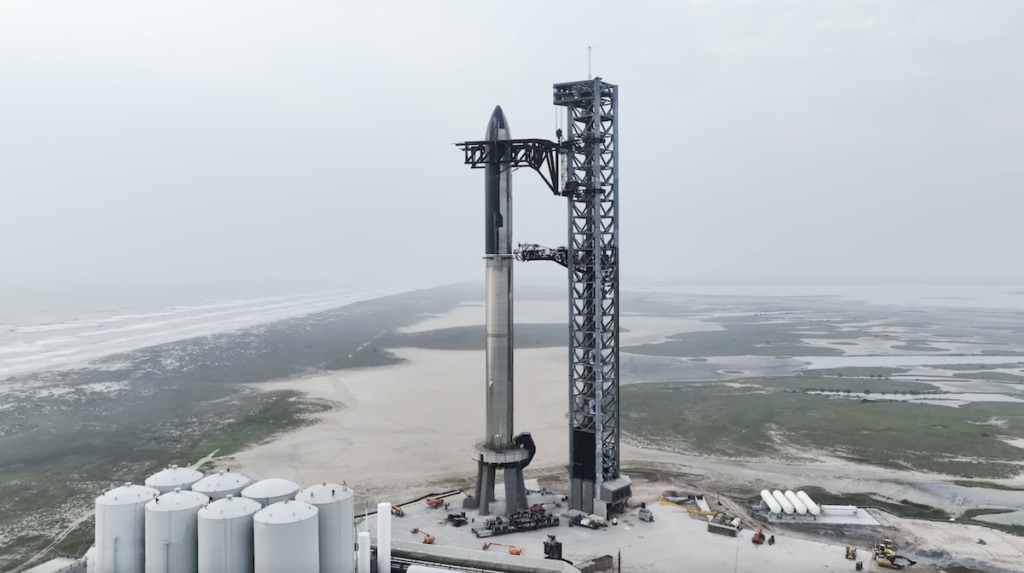
How Did SpaceX’s New Pad Hold Up Against Starship Static Fires?
By now there have been two separate Booster 9 Static fires within the month of August as SpaceX prepares to launch Starship a second time. Both of which used the new water-cooled steel plate to dampen and deflect the heat, power, and sound waves that 33 Raptor engines produce. While only partial thrust and for a few seconds, they still give a great insight into how these pad upgrades have performed and what it will look like on launch day.
Before Starship’s first launch back in April, the static fire certainly didn’t destroy the pad, but it didn’t necessarily provide a lot of confidence in its integrity. Even using partial thrust small pieces of debris could still be seen flying during and after the test. This eventually led to the launch day and complete destruction of the Fondag concrete.
This time around SpaceX is paying a lot more attention to the pad and its surrounding structures. Even launch day timelines have changed which will no doubt have an effect on the pad and what forces it’s exposed to during the launch. Here I will go more in-depth into the state of Starship’s new pad protection, how it held up against two different static fires, the difference on launch day, and more.
Two Static Fires

The first static fire using this new pad infrastructure was earlier this month on the 6th. During the SpaceX live stream, they commented that the test was partial thrust but didn’t go into specifics. Based on other static fires and what we’ve seen in the past we can assume this first test was around 50% thrust. Looking at the footage you can see the water deluge system spraying tons of water well before ignition. Once the engines ignite the Raptor’s thrust pushes down the high water columns and produces a mass amount of steam and large white clouds.
You can also see the flames produced by the engines shooting between the six legs of the orbital launch mount. Each of these legs are protected by a bunch of metal primarily on the inside of the mount but also stretching practically all the way around. Once the static fire was complete water continued to flow out of the steel plate for another few minutes. Drone shots provided by SpaceX after the static fire showed a better view of the pad which looked to be in great condition. Most importantly during the actual test, very little if any actual debris could be seen flying around.
While it was a great test for the pad, 4 of the Booster’s Raptor engines shut down early so we were expecting to see another test. This came very recently on the 25th. This test we got a bit more information on the exact power and forces that were applied to the pad. Specifically, this test was 6 seconds long and all 33 Raptor engines ignited with 2 shutting down early. SpaceX also confirmed that the test produced approximately 7.9 million lbf of thrust (~3,600 metric tons).
To put this number in perspective, not long ago the Space Launch System rocket had its maiden flight and produced around 8.8 million lbf of thrust at liftoff. In other words, this partial thrust static fire of Super Heavy Booster 9 is comparable to the launch of SLS. In SLS’s case, NASA utilizes a massive flame trench combined with a water deluge system to protect the pad and rocket from sound and debris. As of right now, the pad upgrades in Boca Chica have proved to be strong enough to support the launch of some immensely powerful rockets.
Focusing back on the recent tests, before the second static fire even occurred, close-ups during the live stream showed an intact pad ready for a second test just weeks after the first. Similar to the first test about 5 seconds before engine ignition the water began flowing out of the steel plate. This was followed by engine ignition which in relation to the pad, looked very similar to the first test earlier this month. When comparing either of these static fires to the one before Starship’s maiden flight, one of the biggest differences is the plume created. Rather than a dusty plume created by launching against concrete, the water in combination with the steel reinforcement deflects and creates a clean exhaust.
As for the actual launch day, obviously, there are some unknowns until it happens but what we’ve seen so far is very promising. It’s also important to point out that SpaceX is very confident in this approach and in some cases even believes it could be overkill. This is quite a different mindset from the first launch. At the time, SpaceX’s thought process was that the special Fondag concrete should hold up for at least one launch. Now, they have created a solution that intends to be used again and again.
Lastly, the flight profile will be a bit different which should impact the pad and what it has to endure. Specifically, after the first launch Elon was quoted saying, for the next flight, “we’re going to start the engines faster and get off the pad faster.” From engine start to moving Starship “was around 5 seconds, which is a really long time to be blasting the pad.” Going to try to cut that time in half” he said. It will be interesting to see this change in action during the launch.
Launch Prep

With the pad looking to be in good shape, the question becomes what still needs to be completed before Starship lifts off a second time. Only days ago Elon said they were getting ready for the next Starship flight. In reality, the main factor determining when Starship will launch is the FAA. Currently, the next SpaceX Starship launch attempt is still weeks away, pending FAA approval. Modifications, such as the water deluge system, need to be approved. At the same time, it’s likely the FAA and SpaceX have been keeping up with each other for months now and hopefully an approval will come sometime soon.
A few weeks ago a launch notice was released warning of rocket activities in the coming weeks. Based on the wording and timeline, most believe that is talking about an actual launch and not just various testing. Specifically, it was quoted saying, “On August 31st, 2023, mariners operating offshore in waters east of Brownsville, Texas, are advised of rocket launching activities and associated hazardous areas which may impact navigation interests.” It then says, “Mariners should avoid all waters within rocket flight trajectories originating from launch sites and the vicinity of Boca Chica Beach and Brownsville, Texas.”
Notices like these can be amended and also can serve as placeholders as they approach an actual attempt. At the same time, similar notices were issued just weeks before the first attempt in April and served as a hint that the launch was right around the corner. The fact that this was issued recently is a good sign that the company is confident Starship is about ready to lift off.
As for physical progress, a few Starship-related tasks still need to be completed. Once the ship is stacked on Booster 9 there will be a wet dress rehearsal. The Flight Termination System detonator will also need to be installed on the ship and booster once ready. This area in particular had a few issues on the last launch when the termination system took extra time to destroy the stages. Also, with the hot staging addition to Super Heavy the QD arm requires a few upgrades in order to properly reach and fit the necessary stage.
Besides that, it really comes down to the Raptor engines. While impressive, they still are early in development and continually being upgraded. With 33 on a single booster, they need to be consistent and reliable. Even though not every engine is needed to reach orbit, the fewer problems the better. On the first launch, there were quite a few engine issues that SpaceX is hoping to avoid this time. Continuing with the theme of August being a busy month, a few weeks ago SpaceX released footage of a 15-degree Raptor gimbal engine firing. The test lasted over 24 seconds and saw the Raptor attached to the test stand pointing up into the air.
On the bright side, in addition to improvements to the engines themselves, Booster 9 is also helping increase reliability. Elon mentioned before the first launch that the booster heat shield and the Raptor engines were like a box of grenades. On Starship’s first flight, we saw some small explosions with the engines during flight and the eventual loss of multiple Raptors. Elon was quoted after the mission saying, ” At T+27 seconds, SpaceX lost communications due to “some kind of energy event.” And “some kind of explosion happened to knock out the heat shields of engines 17, 18, 19, or 20.” This comment from Musk highlights the correlation and value of these changes. In this case, improvements were specifically made to Booster 9 related to this exact problem and protecting the Raptor engines at the base of the rocket.
With all things considered a launch around late September to early October seems well within reach. Next month will likely be even more busy than August as some of the final launch preparations are made. With a few exceptions, the second launch flight profile is almost identical to the first. The main goal will be getting through stage separation using the new hot staging approach. Considering that this will be the first time they attempt that mission event, it would be a big deal if they do it first try. Either way, the launch is practically guaranteed to be entertaining.
Conclusion
SpaceX learned a valuable lesson on the first launch after Starship sent concrete flying in every direction. So far based on two different static fires the water-cooled steel plate seems to be doing a great job at withstanding the force of 33 Raptor engines. We will have to wait and see how it progresses and the impact it has on the space industry.
